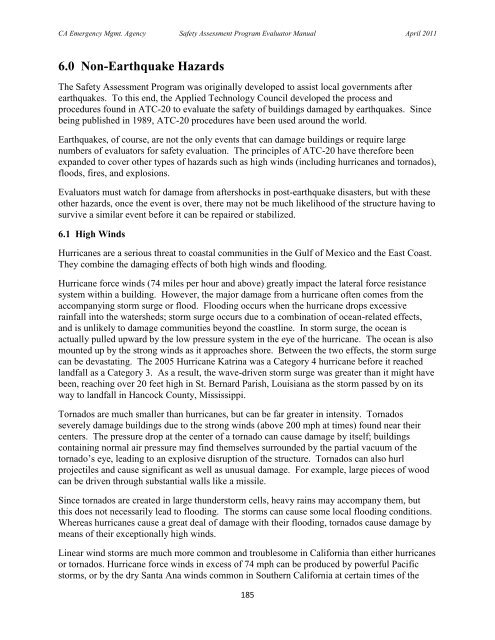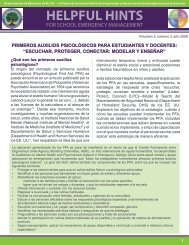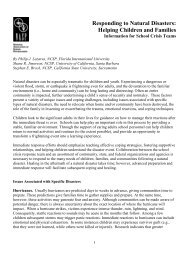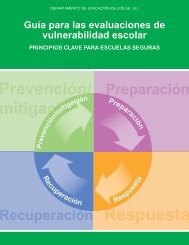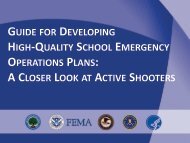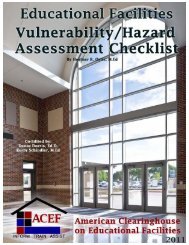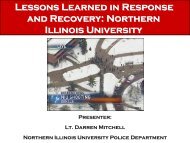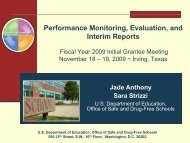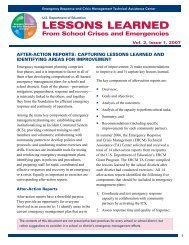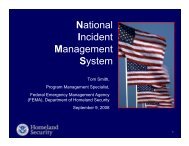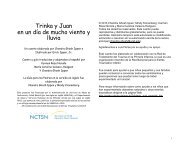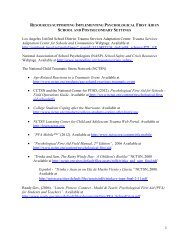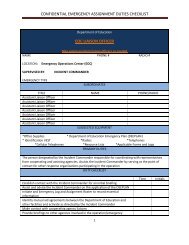Safety Assessment Program Evaluator Student Manual
Safety Assessment Program Evaluator Student Manual
Safety Assessment Program Evaluator Student Manual
You also want an ePaper? Increase the reach of your titles
YUMPU automatically turns print PDFs into web optimized ePapers that Google loves.
CA Emergency Mgmt. Agency <strong>Safety</strong> <strong>Assessment</strong> <strong>Program</strong> <strong>Evaluator</strong> <strong>Manual</strong> April 20116.0 Non-Earthquake HazardsThe <strong>Safety</strong> <strong>Assessment</strong> <strong>Program</strong> was originally developed to assist local governments afterearthquakes. To this end, the Applied Technology Council developed the process andprocedures found in ATC-20 to evaluate the safety of buildings damaged by earthquakes. Sincebeing published in 1989, ATC-20 procedures have been used around the world.Earthquakes, of course, are not the only events that can damage buildings or require largenumbers of evaluators for safety evaluation. The principles of ATC-20 have therefore beenexpanded to cover other types of hazards such as high winds (including hurricanes and tornados),floods, fires, and explosions.<strong>Evaluator</strong>s must watch for damage from aftershocks in post-earthquake disasters, but with theseother hazards, once the event is over, there may not be much likelihood of the structure having tosurvive a similar event before it can be repaired or stabilized.6.1 High WindsHurricanes are a serious threat to coastal communities in the Gulf of Mexico and the East Coast.They combine the damaging effects of both high winds and flooding.Hurricane force winds (74 miles per hour and above) greatly impact the lateral force resistancesystem within a building. However, the major damage from a hurricane often comes from theaccompanying storm surge or flood. Flooding occurs when the hurricane drops excessiverainfall into the watersheds; storm surge occurs due to a combination of ocean-related effects,and is unlikely to damage communities beyond the coastline. In storm surge, the ocean isactually pulled upward by the low pressure system in the eye of the hurricane. The ocean is alsomounted up by the strong winds as it approaches shore. Between the two effects, the storm surgecan be devastating. The 2005 Hurricane Katrina was a Category 4 hurricane before it reachedlandfall as a Category 3. As a result, the wave-driven storm surge was greater than it might havebeen, reaching over 20 feet high in St. Bernard Parish, Louisiana as the storm passed by on itsway to landfall in Hancock County, Mississippi.Tornados are much smaller than hurricanes, but can be far greater in intensity. Tornadosseverely damage buildings due to the strong winds (above 200 mph at times) found near theircenters. The pressure drop at the center of a tornado can cause damage by itself; buildingscontaining normal air pressure may find themselves surrounded by the partial vacuum of thetornado‟s eye, leading to an explosive disruption of the structure. Tornados can also hurlprojectiles and cause significant as well as unusual damage. For example, large pieces of woodcan be driven through substantial walls like a missile.Since tornados are created in large thunderstorm cells, heavy rains may accompany them, butthis does not necessarily lead to flooding. The storms can cause some local flooding conditions.Whereas hurricanes cause a great deal of damage with their flooding, tornados cause damage bymeans of their exceptionally high winds.Linear wind storms are much more common and troublesome in California than either hurricanesor tornados. Hurricane force winds in excess of 74 mph can be produced by powerful Pacificstorms, or by the dry Santa Ana winds common in Southern California at certain times of the185


